抗Anti-Mouse Osteopontin/OPN MAb (Clone 2139B)抗体(Anti-Mouse Osteopontin/OPN MAb (Clone 2139B antibody)
掲載日情報:2018/11/26 現在Webページ番号:232740
Anti-Mouse Osteopontin/OPN MAb (Clone 2139B)に対する抗体(Anti-Mouse Osteopontin/OPN MAb (Clone 2139B )です。
※ 本製品は研究用です。研究用以外には使用できません。
カートに商品を
追加しました。
追加しました。
価格
[在庫・価格 :2024年05月20日 20時55分現在]
※ 表示されている納期は弊社に在庫が無く、取り寄せた場合の納期目安となります。
| 詳細 | 商品名 |
|
文献数 | ||
|---|---|---|---|---|---|
|
Anti-Mouse Osteopontin/OPN MAb (Clone 2139B) |
|
1 | |||
|
Anti-Mouse Osteopontin/OPN MAb (Clone 2139B) |
|
1 | |||
[在庫・価格 :2024年05月20日 20時55分現在]
※ 表示されている納期は弊社に在庫が無く、取り寄せた場合の納期目安となります。
Anti-Mouse Osteopontin/OPN MAb (Clone 2139B)
文献数: 1
- 商品コード:MAB808-SP
- メーカー:RSD
- 包装:25μg
- 価格:¥30,000
- 在庫:無(未発注)
- 納期:2~3週間 ※※ 表示されている納期は弊社に在庫がなく、取り寄せた場合の目安納期となります。
- 法規制等:
Anti-Mouse Osteopontin/OPN MAb (Clone 2139B)
文献数: 1
- 商品コード:MAB808-100
- メーカー:RSD
- 包装:100μg
- 価格:¥96,000
- 在庫:無(未発注)
- 納期:10日程度 ※※ 表示されている納期は弊社に在庫がなく、取り寄せた場合の目安納期となります。
- 法規制等:
カートに商品を
追加しました。
追加しました。
Product Details
| Species Reactivity | Mouse |
|---|---|
| Label | Unconjugated |
| Immunogen | Mouse myeloma cell line NS0-derived recombinant mouse Osteopontin/OPNLeu17-Asn294Accession # Q547B5 |
| Source | Recombinant Monoclonal Rabbit IgG Clone # 2139B |
| Purification | Protein A or G purified from cell culture supernatant |
| Specificity | Detects mouse Osteopontin /OPN in direct ELISAs. |
カートに商品を
追加しました。
追加しました。
Applications and Data
| Recommended Concentration | Sample | |
| Western Blot | 1 µg/mL | See below |
| Immunohistochemistry | 3-25 µg/mL | See below |
| Immunocytochemistry | 3-25 µg/mL | See below |
カートに商品を
追加しました。
追加しました。
Related Product & Information
| Background | Osteopontin/OPN |
|---|---|
| background_content | Background: Osteopontin/OPN Osteopontin (OPN), previously called SPP1 (secreted phosphoprotein 1), Eta-1 (early T lymphocyte activation 1) or BSP (bone sialoprotein), is a secreted molecule in the SIBLING (small integrin-binding ligand N-linked glycoprotein) family of non-collagenous matricellular proteins (1-3). Mouse OPN is synthesized as a 294 amino acid (aa) precursor protein with a 16 aa signal peptide and a 278 aa mature protein (3). Mature mouse OPN shares 79% and 64% aa sequence identity with rat and human OPN, respectively. OPN is highly acidic and has 26 potential Ser/Thr phosphorylation sites and a C‑terminal CD44 binding site (1-4). Depending on tissue-specific modification by O- and N-glycosylation, sulfation, phosphorylation and transglutamination, OPN can be detected at 45-75 kDa (5, 6). The central region of OPN contains RGD and non-RGD binding sites for multiple integrins (3, 4). Adjacent to the RGD motif is the sequence SLAYGLR (SVVYGLR in human) which serves as a cryptic binding site for additional integrins: it is masked in full length OPN but is exposed following OPN cleavage by thrombin in tumors and sites of tissue injury(6-8). OPN can also be cleaved by MMP-3, -7, -9, and -12 within the SLAYGLR motif and at sites closer to the C-terminus (8, 9). OPN is widely expressed and is prominent in mineralized tissues. It inhibits bone mineralization and kidney stone formation, and promotes inflammation and cell adhesion and migration (1, 2, 4, 6). Its expression is up-regulated during inflammation, obesity, atherosclerosis, cancer, and tissue damage, and contributes to the pathophysiology of these conditions (1, 2, 6, 9, 10). |
カートに商品を
追加しました。
追加しました。
製品情報は掲載時点のものですが、価格表内の価格については随時最新のものに更新されます。お問い合わせいただくタイミングにより製品情報・価格などは変更されている場合があります。
表示価格に、消費税等は含まれていません。一部価格が予告なく変更される場合がありますので、あらかじめご了承下さい。





